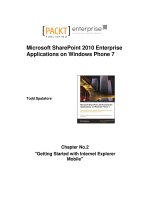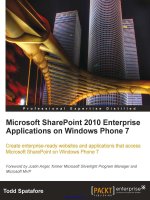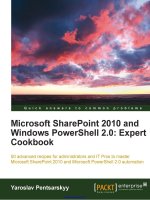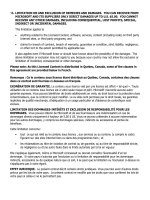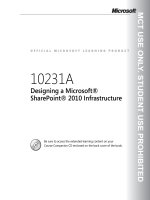microsoft sharepoint 2010 and windows powershell 2.0
Bạn đang xem bản rút gọn của tài liệu. Xem và tải ngay bản đầy đủ của tài liệu tại đây (4.43 MB, 311 trang )
www.it-ebooks.info
Microsoft SharePoint
2010 and Windows
PowerShell 2.0:
Expert Cookbook
50 advanced recipes for administrators and IT Pros
to master Microsoft SharePoint 2010 and Microsoft
PowerShell 2.0 automation
Yaroslav Pentsarskyy
BIRMINGHAM - MUMBAI
www.it-ebooks.info
Microsoft SharePoint 2010 and Windows
PowerShell 2.0: Expert Cookbook
Copyright © 2011 Packt Publishing
All rights reserved. No part of this book may be reproduced, stored in a retrieval system, or
transmitted in any form or by any means, without the prior written permission of the publisher,
except in the case of brief quotations embedded in critical articles or reviews.
Every effort has been made in the preparation of this book to ensure the accuracy of the
information presented. However, the information contained in this book is sold without
warranty, either express or implied. Neither the author, nor Packt Publishing, and its dealers
and distributors will be held liable for any damages caused or alleged to be caused directly or
indirectly by this book.
Packt Publishing has endeavored to provide trademark information about all of the companies
and products mentioned in this book by the appropriate use of capitals. However, Packt
Publishing cannot guarantee the accuracy of this information.
First published: November 2011
Production Reference: 1071111
Published by Packt Publishing Ltd.
Livery Place
35 Livery Street
Birmingham B3 2PB, UK.
ISBN 978-1-84968-410-1
www.packtpub.com
Cover Image by John Green ()
www.it-ebooks.info
Credits
Author
Yaroslav Pentsarskyy
Reviewers
Muhammad A. Piracha
Ravikanth C
Acquisition Editor
Stephanie Moss
Development Editor
Maitreya Bhakal
Technical Editor
Manasi Poonthottam
Project Coordinator
Kushal Bhardwaj
Proofreader
Joel T. Johnson
Indexer
Monica Ajmera Mehta
Production Coordinator
Melwyn D'sa
Cover Work
Melwyn D'sa
www.it-ebooks.info
About the Author
Yaroslav Pentsarskyy has been involved in SharePoint solution architecture and
implementation since 2003. He has been a Microsoft MVP since 2009 and keeps in close
contact with the SharePoint product team. Yaroslav frequently presents at technical events
worldwide as well as online. You can always nd a fresh bit of SharePoint information on his
blog:
. To learn everything Yaroslav knows about SharePoint,
check out his two new books Top 60 Custom Solutions built on SharePoint 2010 and
SharePoint 2010 branding in practice.
www.it-ebooks.info
About the Reviewers
Muhammad A. Piracha is a senior Software Engineer at Bamboo Solutions Corporation,
which is based in Reston, Virginia. Bamboo Solutions is a leading provider of software
solutions for the Microsoft SharePoint platform. Muhammad has over 15 years of experience
in building document management software applications using various Microsoft products.
He has experience in a variety of capacities, including architecting, designing, and developing
software for SharePoint technologies since its release in 2003. When he is not on a computer
writing code, he enjoys spending time with his family and outdoor activities.
Ravikanth C has more than 10 years of experience in the IT industry. In the beginning
of his career, he worked at Wipro Infotech managing Windows, Solaris servers, and Cisco
network equipment. He currently works at Dell Inc. as a lead engineer in the SharePoint
solutions group. As a part of his work, he has authored several whitepapers on MOSS 2007
and SharePoint 2010 that provide guidance around infrastructure elements of a SharePoint
deployment. His work also involves performance testing and sizing of SharePoint workloads
on Dell servers and storage. Ravikanth is passionate about automation and outside of work
he writes regularly on his blog, about topics
related to Windows PowerShell, Microsoft SharePoint, and Windows Server virtualization.
In 2010, Ravikanth received Microsoft's Most Valuable Professional (MVP) award in Windows
PowerShell. You can also hear him speak regularly at BITPro () user
group meetings and other in-person events at Bangalore, India.
www.it-ebooks.info
www.PacktPub.com
Support les, eBooks, discount offers, and more
You might want to visit www.PacktPub.com for support les and downloads related to
your book.
Did you know that Packt offers eBook versions of every book published, with PDF and ePub les
available? You can upgrade to the eBook version at www.PacktPub.com and as a print book
customer, you are entitled to a discount on the eBook copy. Get in touch with us at service@
packtpub.com for more details.
At www.PacktPub.com, you can also read a collection of free technical articles, sign up
for a range of free newsletters and receive exclusive discounts and offers on Packt books
and eBooks.
Do you need instant solutions to your IT questions? PacktLib is Packt's online digital book library.
Here, you can access, read and search across Packt's entire library of books.
Why Subscribe?
f Fully searchable across every book published by Packt
f Copy and paste, print and bookmark content
f On demand and accessible via web browser
Free Access for Packt account holders
If you have an account with Packt at www.PacktPub.com, you can use this to access PacktLib today
and view nine entirely free books. Simply use your login credentials for immediate access.
Instant Updates on New Packt Books
Get notied! Find out when new books are published by following @PacktEnterprise on Twitter, or
the Packt Enterprise Facebook page.
www.it-ebooks.info
Table of Contents
Preface 1
Chapter 1: PowerShell Scripting Methods and Creating Custom
Commands 7
Introduction 7
Setting up your Virtual Machine and running a test script 8
Authoring, debugging, and executing script accessing farm settings
with PowerGUI and PowerShell ISE 10
Accessing advanced SharePoint 2010 functionality with external libraries 17
Creating a custom PowerShell command (CmdLet) 22
Creating a custom PowerShell Snap-In 26
Chapter 2: Enterprise Content Deployment and Provisioning
Using PowerShell 33
Introduction 33
Provisioning site hierarchy during solution deployment 34
Installing features on the site and managing existing site features 39
Creating permission levels and security groups that use them 46
Managing site templates and their availability on sites 50
Associating features to existing site templates 55
Managing SharePoint workow association using PowerShell 60
Conguring site themes and user interface artifacts 65
Chapter 3: Performing Advanced List and Content Operations
in SharePoint using PowerShell 73
Introduction 73
Creating lists of custom structures 74
Setting SharePoint list item validation with PowerShell 78
Setting list item security 84
www.it-ebooks.info
ii
Table of Contents
Setting list relationships 89
Customizing list views 94
Managing the use of content types in lists 99
Chapter 4: Managing External Data in SharePoint and Business
Connectivity Services using PowerShell 105
Introduction 105
Importing a custom BCS model to SharePoint 106
Exporting SharePoint BCS model and schema 111
Creating instances of external lists with PowerShell 116
Managing permissions on an external list 121
Throttling items returned with external lists 127
Chapter 5: Managing SharePoint 2010 Metadata and Social Features
Using PowerShell 133
Introduction 133
Creating new user proles 134
Adding and conguring new prole properties 140
Bulk provisioning data into user prole properties 145
Creating, importing, and exporting managed metadata taxonomy terms 151
Enabling social ratings on lists and libraries 157
Bulk tagging content and deleting tags in SharePoint 162
Chapter 6: Managing SharePoint Search and FAST Search
with PowerShell 169
Introduction 169
Conguring search query suggestions in your search center 170
Conguring search best bets 175
Conguring visual best bets 180
Conguring search audience targeting 186
Conguring search web parts automatically with PowerShell 191
Chapter 7: Managing SharePoint Site Content in Bulk using
PowerShell 199
Introduction 199
Creating basic and complex content types 200
Creating and conguring document sets 205
Creating and editing publishing pages with PowerShell 211
Provisioning web parts in bulk on to SharePoint pages 217
Conguring web parts in bulk with PowerShell 222
Provisioning list rollups using Powershell 227
Chapter 8: Managing Documents and Records in SharePoint
with PowerShell 233
www.it-ebooks.info
iii
Table of Contents
Introduction 233
Provisioning documents and records center with PowerShell 234
Conguring record routing 240
Conguring a common record expiration policy 246
Creating a custom expiration policy for the record 252
Conguring content hub for content types used in records center 257
Chapter 9: Administrating Web Application and Server Administration
in SharePoint with PowerShell 263
Introduction 263
Conguring web application settings 264
Parsing SharePoint logs using PowerShell 271
Managing web application throttling settings 276
Conguring sandbox solution policies 282
Managing sandbox solutions in SharePoint site collections 286
Index 293
www.it-ebooks.info
iv
Table of Contents
www.it-ebooks.info
Preface
PowerShell is tightly integrated with SharePoint 2010, demonstrating an important alliance
between the fastest growing collaboration and web publishing platform, and the latest task
automation framework. The advantages of PowerShell and SharePoint integration help
administrators and infrastructure specialists achieve everyday enterprise tasks more efciently,
and this book will ensure you get the most out of SharePoint conguration and management.
When it comes to custom SharePoint 2010 solution conguration, creating robust PowerShell
scripts is the best option for saving time and providing a point of reference to when changes
are made in the server environment. This practical expert cookbook translates the most
commonly found scenarios into a series of immediately usable recipes, allowing you to get up
and running straight away with writing powerful PowerShell scripts for SharePoint.
Microsoft SharePoint 2010 and Windows PowerShell 2.0: Expert Cookbook focuses on a
range of distinct areas of SharePoint administration, with expert recipes targeting unique
business examples.
You will learn exactly how solutions were achieved for managing SharePoint list settings with
PowerShell, PowerShell conguration of SharePoint FAST Search, and more. You will also learn
how to tailor the recipe to your own business needs.
With this advanced cookbook in hand, you will be fully equipped with the source code as a
starting point for creating your scripts in order to take advantage of the integration between
SharePoint and PowerShell.
What this book covers
Chapter 1, PowerShell Scripting Methods and Creating Custom Commands: Go further with
PowerShell to create your own PowerShell commands (CmdLets) and snap-ins and share them
with your team.
Chapter 2, Enterprise Content Deployment and Provisioning using PowerShell: Automate your
SharePoint 2010 custom solution deployment by using a robust PowerShell script.
www.it-ebooks.info
Preface
2
Chapter 3, Performing Advanced List and Content Operations in SharePoint using PowerShell:
Master the management of SharePoint lists and list settings with PowerShell.
Chapter 4, Managing External Data in SharePoint and Business Connectivity Services
using PowerShell: Get to the bottom of administering Business Connectivity Services (BCS)
in SharePoint.
Chapter 5, Managing SharePoint 2010 Metadata and Social Features using PowerShell:
Learn all about performing the most common congurations around SharePoint taxonomy
features and user prole services.
Chapter 6, Managing SharePoint Search and FAST Search with PowerShell: Congure
SharePoint FAST Search using PowerShell including audience targeting and improving
search results.
Chapter 7, Managing SharePoint Site Content in Bulk using PowerShell: Congure content
on SharePoint pages including bulk provisioning and conguration publishing pages, content
types and web parts.
Chapter 8, Managing Documents and Records in SharePoint with PowerShell: Get the most
out of document and records management in SharePoint 2010 by automating conguration.
Chapter 9, Administrating Web Application and Server Administration in SharePoint with
PowerShell: Simplify SharePoint server management by using PowerShell for tasks like web
application settings, conguration and monitoring, sandbox features, and more.
What you need for this book
To complete the tasks in this book, you will need a system with SharePoint 2010 Server
Standard installed. Some areas of the book will require FAST Search to be installed
and congured. We recommend downloading and installing 2010 Information Worker
Demonstration and Evaluation Virtual Machine (RTM) Virtual Machine environment if you
do not have a compatible system set up. The most current link to download the virtual
environment can be retrieved by searching for the 2010 Information Worker Demonstration
and Evaluation Virtual Machine (RTM). By downloading the preceding environment, you will
ensure all of the congurations and setups have been performed and your system is ready for
using PowerShell with SharePoint.
Who this book is for
If you are a SharePoint administrator or IT Pro who wants to extend your knowledge of
PowerShell automation, this book is a must have. You should have a solid grasp of working
with SharePoint and PowerShell.
www.it-ebooks.info
Preface
3
Conventions
In this book, you will nd a number of styles of text that distinguish between different kinds of
information. Here are some examples of these styles, and an explanation of their meaning.
Code words in text are shown as follows: " Set the lename of the script to
ManageSandbox.ps1."
A block of code is set as follows:
$QuotaTemplate.UserCodeMaximumLevel = 200
$QuotaTemplate.UserCodeWarningLevel = 100
$AdminService.Update()
When we wish to draw your attention to a particular part of a code block, the relevant lines or
items are set in bold:
$SPSite.WebApplication.Update()
Write-Host "Web application configuration complete"
}
$SPSite.Dispose()Any command-line input or output is written as
follows:
PS C:\Users\Administrator\Desktop> .\ WebApplicationThrottling.ps1
New terms and important words are shown in bold. Words that you see on the screen, in
menus or dialog boxes for example, appear in the text like this: "Click File | Save to save the
script to your development machine's desktop."
Warnings or important notes appear in a box like this.
Tips and tricks appear like this.
Reader feedback
Feedback from our readers is always welcome. Let us know what you think about this
book—what you liked or may have disliked. Reader feedback is important for us to develop
titles that you really get the most out of.
To send us general feedback, simply send an e-mail to
, and
mention the book title via the subject of your message.
www.it-ebooks.info
Preface
4
If there is a book that you need and would like to see us publish, please send us a note in the
SUGGEST A TITLE form on www.packtpub.com or e-mail
If there is a topic that you have expertise in and you are interested in either writing or
contributing to a book, see our author guide on www.packtpub.com/authors.
Customer support
Now that you are the proud owner of a Packt book, we have a number of things to help you to
get the most from your purchase.
Downloading the example code
You can download the example code les for all Packt books you have purchased from your
account at . If you purchased this book elsewhere, you can
visit and register to have the les e-mailed
directly to you.
Errata
Although we have taken every care to ensure the accuracy of our content, mistakes do
happen. If you nd a mistake in one of our books—maybe a mistake in the text or the
code—we would be grateful if you would report this to us. By doing so, you can save other
readers from frustration and help us improve subsequent versions of this book. If you nd
any errata, please report them by visiting selecting
your book, clicking on the errata submission form link, and entering the details of your
errata. Once your errata are veried, your submission will be accepted and the errata
will be uploaded on our website, or added to any list of existing errata, under the Errata
section of that title. Any existing errata can be viewed by selecting your title from
/>www.it-ebooks.info
Preface
5
Piracy
Piracy of copyright material on the Internet is an ongoing problem across all media. At Packt,
we take the protection of our copyright and licenses very seriously. If you come across any
illegal copies of our works, in any form, on the Internet, please provide us with the location
address or website name immediately so that we can pursue a remedy.
Please contact us at with a link to the suspected
pirated material.
We appreciate your help in protecting our authors, and our ability to bring you
valuable content.
Questions
You can contact us at if you are having a problem with any
aspect of the book, and we will do our best to address it.
www.it-ebooks.info
www.it-ebooks.info
1
PowerShell Scripting
Methods and Creating
Custom Commands
In this chapter, we will cover:
f Setting up your Virtual Machine and running a test script
f Authoring, debugging, and executing script accessing farm settings with PowerGUI
and PowerShell ISE
f Accessing advanced SharePoint 2010 functionality with external libraries
f Creating a custom PowerShell command (CmdLet)
f Creating a custom PowerShell Snap-In
Introduction
PowerShell as a scripting language will execute actions on your target environment. Scripting
is not a new concept and PowerShell is denitely not a new language. However, PowerShell
and SharePoint 2010 integrate very well. This integration allows administrators and
developers to access not just a limited set of commands, but also to connect to SharePoint
objects and libraries to take advantage of additional capabilities of SharePoint as a platform.
To ensure that we are on the same page while reading this book and trying out various
recipes, we'll start by setting up your environment and verifying the setup by running a test
script. After all, SharePoint relies on components, most of which we're going to be directly
interacting with, and having a consistently congured environment will help in reducing any
potential integration issues.
www.it-ebooks.info
PowerShell Scripting Methods and Creating Custom Commands
8
Although we can author our PowerShell scripts in Notepad and execute them in a PowerShell
command-line environment, you can experience more advantages from authoring and
debugging your scripts by using rich authoring environments, such as PowerGUI or PowerShell
ISE. In this chapter, we'll see exactly what the benets of using those environments are.
Whether you are creating a PowerShell script in a professional scripting environment or calling
an existing script from a command line, you'll quickly notice that a default set of commands
is denitely not enough to manage and work with your SharePoint system. When you have the
need to author scripts accessing various other aspects of SharePoint functionality, you will
need to use the additional libraries available to facilitate custom or out-of-the-box functionality
required. This is a very common scenario for developers when building custom solutions for
a variety of platforms. PowerShell, as a scripting language, really takes advantage of this
concept allowing you to call functions from SharePoint and third-party libraries. In this chapter,
we'll take a look at exactly how you can access advanced SharePoint 2010 functionality using
external libraries.
As you become more familiar with authoring PowerShell scripts, you will realize that you can
create a collection of reusable functionality which can be shared with others. That's when you
can take advantage of sealing your custom functionality in a portable and sharable way. We'll
take a look at how you can package your custom scripts as custom PowerShell CmdLets, as
well as how to create a custom PowerShell Snap-In.
Setting up your Virtual Machine and
running a test script
In this recipe, we'll ensure your development environment is congured properly.
Getting ready
To complete the recipes in this book, it's assumed you're running a system with SharePoint
2010 Server Standard installed. If not, it is recommended you download and install the 2010
Information Worker Demonstration and Evaluation Virtual Machine (RTM) Virtual Machine
environment, if you do not have a compatible system set up. For the most current link to
download this virtual environment, search Microsoft Download Center with the keyword 2010
IW demo RTM.
By downloading the preceding environment, you will ensure all of the congurations and
setups have been performed and your system is ready for using PowerShell with SharePoint.
Whether you're using your own or a downloaded Virtual Machine, let's ensure PowerShell is
enabled in your environment.
www.it-ebooks.info
Chapter 1
9
How to do it
Let's see how you can get your virtual environment congured and run your rst script using
the following steps:
1. On the target Virtual Machine, ensure you are logged in with an administrator's role.
2. Click Start | All Programs | Microsoft SharePoint 2010 Products | SharePoint
2010 Management Shell.
3. Input Get-ExecutionPolicy and press Enter on your keyboard. PowerShell may
return a value of Restricted.
4. Input Set-ExecutionPolicy Unrestricted and hit Enter.
Ensure this policy is reverted back on your production environments to
avoid the risk of malicious script execution.
5. Input the following command in the window:
Get-SPSite | Where-Object {$_.Url -eq "toso.
com"}
6. You should see a result that looks similar to the following screenshot:
How it works
On Windows 2008 Server, PowerShell script execution policy is set to restrict script execution
by default. As an administrator, you can choose to allow script execution by calling the
Set-ExecutionPolicy Unrestricted command.
www.it-ebooks.info
PowerShell Scripting Methods and Creating Custom Commands
10
For more information on options available for script execution policy and
how it affects your environment, search TechNet with the keyword Set-
ExecutionPolicy.
Once script execution is not restricted, we run a PowerShell command enumerating all of the
SharePoint sites with the URL. This assumes you have
an existing site collection with such a URL. If you're using the downloadable environment from
above, the site collection will be already set up for you. If you're running a site collection with a
different URL, feel free to replace the value in this example.
There's more
In this example, we assumed you were running a Virtual Machine downloaded from the
Microsoft download site with all of the pre-set options. In this case, you may see that the
execution policy has already been set to unrestricted. In this case, you don't need to set
the value again.
Authoring, debugging, and executing
script accessing farm settings with
PowerGUI and PowerShell ISE
As you can see from the previous recipe, authoring and executing a PowerShell script is a
simple task that can be done right from the command line. In this recipe, we'll take a look at
how you can author and debug your PowerShell scripts using two of the most popular tools:
PowerShell ISE and PowerGUI. Using these tools, we'll execute a script accessing farm
settings of the SharePoint site.
Getting ready
First, let's ensure you have installed PowerShell ISE:
1. On the target Virtual Machine, click Start | Administrative Tools | Server Manager.
2. On the left-hand side panel of the Server Manager window, click the Features node.
3. In the main window of the Server Manager, click Add Features.
4. From the Add Features Wizard, ensure Windows PowerShell Integrated Scripting
Environment (ISE) is selected. If it is selected and grayed out, as seen in the following
screenshot, skip to Step 6 in this sequence.
www.it-ebooks.info
Chapter 1
11
5. Click Next and Install on the following window to install the feature.
6. Upon installation completion, close the Server Manager window.
Let's now install PowerGUI:
1. Navigate to or search the Internet with PowerGUI.
2. Download the latest version of PowerGUI installer.
3. Run the installation package on your development environment and install the
PowerGUI tool using the default installation options.
Now that you have all of the tools installed, let's use PowerShell ISE and PowerGUI to author,
debug, and execute our new script.
How to do it
Let's see how PowerShell ISE and PowerGUI can help with your script authoring.
1. On your development environment, click Start | All Programs | Accessories |
Windows PowerShell | Windows PowerShell ISE.
www.it-ebooks.info
PowerShell Scripting Methods and Creating Custom Commands
12
2. In the PowerShell ISE window's top section, type in the following script:
$siteUrl = ""
$snapin = Get-PSSnapin | Where-Object {$_.Name -eq 'Microsoft.
SharePoint.Powershell'}
if ($snapin -eq $null) {
Write-Host "Loading SharePoint Powershell Snapin"
Add-PSSnapin "Microsoft.SharePoint.Powershell"
}
$site = Get-SPSite | Where-Object {$_.Url -eq $siteUrl}
$site.WebApplication.QueryFeatures("00BFEA71-EC85-4903-972D-
EBE475780106")
Downloading the example code
You can download the example code es for all Packt books you have
purchased from your account at . If you
purchased this book elsewhere, you can visit ktPub.
com/support and register to have the es e-mailed directly to you.
3. Press F5 on your keyboard.
4. Take a note of the results returned by the script which will contain multiple instances
in the following format:
DefinitionId : 00bfea71-ec85-4903-972d-ebe475780106
Parent : My
Properties : {}
Definition : SPFeatureDefinition
Name=FeatureDefinition/00bfea71-ec85-4903-972d-ebe475780106
Version : 3.0.0.0
FeatureDefinitionScope : Farm
5. Now let's see the result with PowerGUI. On your development environment, click Start
| All Programs | PowerGUI | PowerGUI Script Editor.
6. In the top section of the PowerGUI editor, insert the same code we used in step 2 of
this sequence:
$siteUrl = ""
$snapin = Get-PSSnapin | Where-Object {$_.Name -eq 'Microsoft.
SharePoint.Powershell'}
if ($snapin -eq $null) {
Write-Host "Loading SharePoint Powershell Snapin"
Add-PSSnapin "Microsoft.SharePoint.Powershell"
www.it-ebooks.info
Chapter 1
13
}
$site = Get-SPSite | Where-Object {$_.Url -eq $siteUrl}
$site.WebApplication.QueryFeatures("00BFEA71-EC85-4903-972D-
EBE475780106")
7. Press F5 to execute your script.
8. Take a note of the same result set in the PowerShell Console window right below the
editor, seen in the previous image.
9. Switch back to the script editor section of the screen and set your cursor on the last
line of the code.
10. Press F9 to set the breakpoint on the last line of the code.
11. Press F5 to execute the script up to the breakpoint.
www.it-ebooks.info
PowerShell Scripting Methods and Creating Custom Commands
14
12. Take a note of the script editor window when the script has been executed up to the
breakpoint. Your PowerGUI editor will look similar to the following screenshot:
13. At this point you can press F5 on your keyboard to continue execution.
How it works
We launched the PowerShell ISE to execute our custom script. The rst thing our script
is going to do is load the PowerShell cmdlet library for SharePoint. This extension library
holds various PowerShell functions allowing us to work with SharePoint objects from within
PowerShell. Once the library is loaded, our script connects to our SharePoint site, http://
intranet.contoso.com,
and gets a hold of the current site. Further, the script calls a
function which enumerates all of the SharePoint sites and their basic details which have a
specied featured ID active in them, as seen in the following screenshot
www.it-ebooks.info

